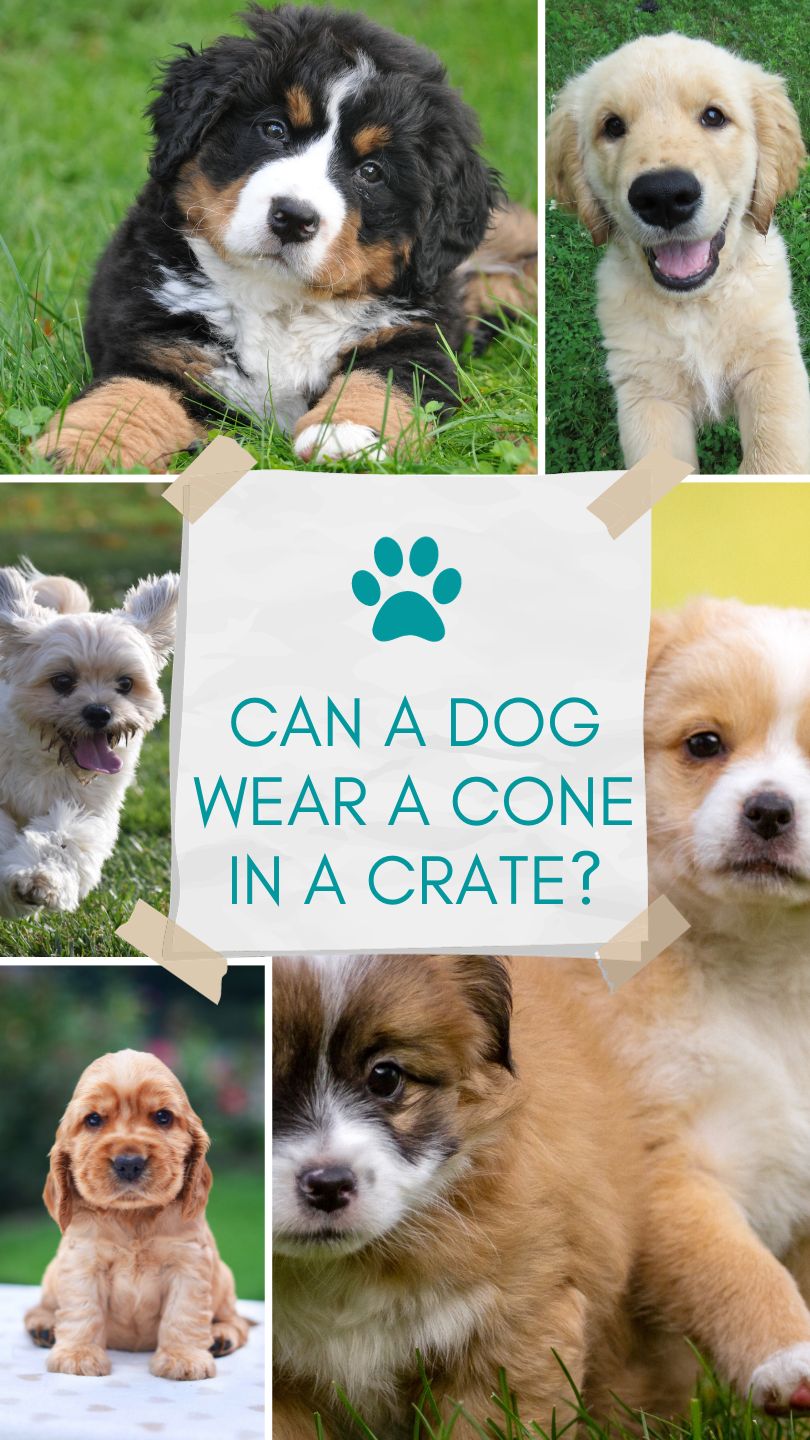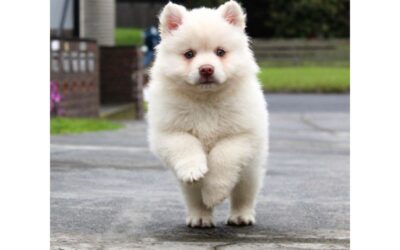Yes, a dog can wear a cone in a crate for its safety and to prevent self-injury. Introducing a dog to a crate can be a useful tool for house training or to provide a safe space.
- Cone Wearing In Crates: Is It Safe And Beneficial?
- Finding The Right Cone For Crate Wearing
- Introducing The Cone To Your Dog In The Crate
- Overcoming Challenges: Potential Issues With Crate Cone Wearing
- Additional Comfort Measures For Dogs Wearing Cones In Crates
- Promoting Positive Experiences: Enrichment Activities For Dogs Wearing Cones In Crates
- Monitoring And Assessing The Effectiveness Of Crate Cone Wearing
- Frequently Asked Questions For Can A Dog Wear A Cone In A Crate
- Conclusion
However, sometimes dogs may have certain medical conditions that require them to wear a cone to prevent them from licking or biting at wounds or stitches. In these cases, it is important to ensure that the dog is still able to wear the cone even when inside the crate.
This can help to minimize the risk of self-inflicted harm and aid in the healing process. By allowing the dog to wear the cone in the crate, it provides a barrier between the dog and any areas that may need protection, allowing the dog to rest or sleep comfortably while still avoiding any further damage or irritation.
Cone Wearing In Crates: Is It Safe And Beneficial?
Cone wearing in crates for dogs—safe or beneficial? Learn about the advantages and considerations of using a cone in a crate to ensure your pet’s well-being during recovery or training.
Crating your dog during their recovery period can provide them with a safe and comfortable space to rest and heal. However, many pet owners wonder if it is safe and beneficial for their dogs to wear a cone while in the crate.
In this section, we’ll explore the importance of using a cone for dog recovery and how crating can aid in the rest and healing process.
The Importance Of Using A Cone For Dog Recovery:
- Prevents licking and scratching: Dogs tend to lick or scratch at wounds, surgical incisions, or irritated areas. This behavior can slow down the healing process and even lead to infections. Using a cone prevents access to these areas, allowing them to heal undisturbed.
- Reduces the risk of self-inflicted injuries: By wearing a cone, dogs are unable to bite or lick areas that may be sore or healing. This reduces the risk of self-inflicted injuries and potential complications, promoting a faster and smoother recovery.
- Protects against external hazards: Cones act as a physical barrier between your dog’s face and potential hazards in their environment. They prevent accidental bumps, scratches, or contact with substances that could irritate or damage the wound.
How Crating Can Aid In Dog’S Rest And Healing Process:
- Provides a secure and quiet environment: Crates offer a cozy and secure space for dogs to rest and recover. The confined space helps reduce their mobility, preventing excessive movement that could hinder the healing process.
- Minimizes distractions and overstimulation: By confining your dog to a crate, you minimize external distractions and overstimulation, allowing them to relax and focus on healing. This controlled environment can help reduce stress and anxiety levels, promoting a more comfortable recovery period.
- Prevents accidental injuries: When your dog wears a cone in the crate, you can have peace of mind knowing that they are protected from accidentally injuring themselves. The combination of crate confinement and cone usage ensures that they avoid any unnecessary movements that may put their recovery at risk.
- Limits access to restricted areas: Some injuries or surgeries may require restricted movements, such as limited mobility or avoidance of specific spaces. Crating with a cone provides a controlled environment where your dog can safely recover without the risk of accessing these restricted areas.
Using a cone for dog recovery while crating is both safe and beneficial. It prevents licking and scratching, reduces the risk of self-inflicted injuries, and protects against external hazards. Additionally, crating provides a secure and quiet environment, minimizes distractions and overstimulation, prevents accidental injuries, and limits access to restricted areas.
By following these precautions, you can ensure your dog’s recovery is as smooth and comfortable as possible.
Finding The Right Cone For Crate Wearing
A dog wearing a cone may find it difficult to comfortably fit in a crate. It is important to find the right cone for crate wearing to ensure your furry friend’s well-being and comfort during confinement.
Finding the right cone for your dog to wear in a crate can be a crucial step in ensuring their safety and comfort. Whether your furry friend is recovering from surgery or simply needs some time to calm down, a cone can be a useful tool.
However, it’s important to choose the right cone to avoid any unnecessary discomfort.
Factors To Consider When Choosing A Cone For Crate Wearing:
When selecting a cone for your dog to wear in a crate, there are a few key factors to consider:
- Size: Ensuring the cone fits your dog properly is essential for their comfort. A cone that is too small may not provide enough protection, while a cone that is too big can hinder their movement. Measure your dog’s neck circumference accurately before purchasing a cone.
- Material: Cones are made from various materials, including plastic, fabric, and inflatable options. Plastic cones are sturdy and provide maximum protection, while fabric cones are more flexible and comfortable. Inflatable cones are an excellent choice for dogs who need to wear a cone for an extended period as they allow more freedom of movement.
- Design: Consider the design of the cone and how it will affect your dog’s ability to move, lie down, and rest comfortably in their crate. Some cones have a wider opening at the front, allowing your dog to eat and drink more easily, while others have a solid cone shape that offers maximum protection.
- Collar Compatibility: If your dog wears a collar or a harness, ensure that the cone you choose is compatible with these accessories. Some cones have openings or attachments that allow you to secure them to your dog’s collar or harness, ensuring they stay in place.
Measuring Your Dog Correctly For A Proper Fit:
To ensure a proper fit, it’s crucial to measure your dog accurately before purchasing a cone. Follow these steps:
- Take a flexible measuring tape and wrap it around the widest part of your dog’s neck, just below their ears.
- Make sure the tape is snug but not too tight.
- Note down the measurement and use it as a reference when selecting the appropriate cone size.
Remember, when it comes to choosing a cone for crate wearing, finding the right fit is essential to avoid any discomfort or hindrance to your dog’s movement. Take into account the size, material, design, and collar compatibility to ensure your dog’s well-being while they are in their crate.
Introducing The Cone To Your Dog In The Crate
Introduce your dog to wearing a cone in the crate for their comfort and safety. Help them adjust gradually by providing positive reinforcement and ensuring they can still move comfortably while wearing the cone.
Gradual And Positive Cone Introduction Techniques For Crate Training
- Start by introducing the cone to your dog when they are outside the crate. Allow them to sniff and investigate it so they become familiar with it. This will help to reduce any initial fear or anxiety they may have.
- Place treats or small amounts of their favorite food inside the cone to create positive associations. This will help your dog view the cone as something positive and rewarding.
- Use shaping techniques to gradually increase your dog’s comfort level with the cone. For example, start by rewarding them for simply touching the cone with their nose, then progress to keeping their nose inside the cone for a few seconds before giving them a treat.
- Once your dog seems comfortable wearing the cone outside the crate, gradually transition to having them wear it inside the crate. Start with short periods of time and gradually increase the duration as your dog becomes more comfortable.
- It’s important to monitor your dog closely during the initial introduction to wearing a cone in the crate. Look for any signs of distress or discomfort, and adjust the training accordingly.
Helping Your Dog Adjust To Wearing A Cone In The Crate
- Create a positive and inviting crate environment by placing your dog’s favorite toys, blankets, or bedding inside the crate. This will help your dog associate the crate with comfort and safety.
- Ensure that the crate is appropriately sized for your dog, with enough room for them to wear the cone without feeling restricted comfortably.
- Gradually increase your dog’s time in the crate while wearing the cone. Provide them with plenty of mental and physical stimulation during crate time, such as puzzle toys or interactive feeding toys.
- Use positive reinforcement techniques, such as giving treats or praise, whenever your dog exhibits calm behaviour while wearing the cone in the crate. This will help them associate the cone with positive experiences and reduce any anxiety.
- Be patient with your dog’s adjustment process. Each dog is unique and may require different amounts of time to become comfortable wearing a cone in the crate. Consistency and positive reinforcement will help your dog adapt more easily.
Remember, introducing your dog to wearing a cone in the crate requires patience, positive reinforcement, and gradual training. By using these techniques, you can help your dog feel more comfortable and relaxed while wearing the cone in the crate.
Overcoming Challenges: Potential Issues With Crate Cone Wearing
When crate training a dog, wearing a cone can pose potential challenges. Dogs may find it uncomfortable or restrictive, limiting their movement and ability to relax. However, with patience and proper training, dogs can overcome these issues and adapt to wearing a cone in the crate.
When it comes to creating a dog that is wearing a cone, there are a few potential challenges that may arise. These challenges can vary from stress and anxiety related to cone-wearing to interference with eating, drinking, and sleeping.
It is important to address these issues to provide your furry friend with the best possible experience. This section will discuss techniques for preventing stress and anxiety related to cone-wearing in the crate and ways to avoid cone interference with essential activities such as eating, drinking, and sleeping.
Preventing Stress And Anxiety Related To Cone Wearing In The Crate
Crate cone-wearing can cause stress and anxiety for dogs, especially if they are not used to being confined in a crate or wearing a cone. Here are some techniques to help alleviate their distress:
- Gradual: Introduce the crate and the cone to your dog gradually, allowing them to become familiar with each item separately before combining them.
- Positive Reinforcement: Use treats and praise to create positive associations with the crate and the cone, helping your dog see them as less threatening.
- Comfort Zone: Make the crate a comfortable and inviting space by adding blankets, pillows, and familiar scents that your dog enjoys.
Techniques For Avoiding Cone Interference With Eating, Drinking, And Sleeping
Wearing a cone can hinder a dog’s ability to perform essential activities such as eating, drinking, and sleeping comfortably. Here are a few techniques to overcome these challenges:
- Cone Modification: Consider modifying the cone to allow easier food and water access. You can try cutting a small hole in the cone to accommodate a food bowl or water dispenser.
- Elevated Feeding: Raise your dog’s food and water bowls to a comfortable height using a raised platform or props to ensure easy access without interference from the cone.
- Temporary Removal: If your dog is comfortable and supervised, you may temporarily remove the cone during meals and sleep to allow for uninterrupted eating and rest. However, consult your veterinarian before doing so.
- Alternative Resting Spots: If your dog finds sleeping comfortably in the crate with the cone difficult, consider providing alternative resting spots such as a soft bed or a designated cosy corner in a safe area of the house.
Remember, every dog is different, and what works for one may not work for another. It is always crucial to consult with your veterinarian for personalized advice and recommendations tailored to your dog’s specific needs. By taking these precautions and employing these techniques, you can help make the experience of wearing a cone in the crate as stress-free and comfortable as possible for your furry companion.
Additional Comfort Measures For Dogs Wearing Cones In Crates
Dogs can wear cones in crates for added comfort. To ensure their well-being, consider using soft, padded bedding, providing soothing music or white noise, and following a regular exercise and mental stimulation routine.
Dogs can sometimes develop injuries or undergo medical procedures that require them to wear a cone. While wearing a cone is essential for their safety and recovery, it can pose some challenges, especially when it comes to being confined in a crate.
In this section, we will explore additional comfort measures for dogs wearing cones in crates to ensure their well-being during recovery.
Padding And Cushioning Options To Enhance Comfort Inside The Crate:
- Use soft bedding: Provide your dog with a comfortable crate bed made of soft materials such as memory foam or plush fabric. This will help cushion their body and create a cosy space for them.
- Opt for crate mats or pads: You can consider using crate mats or pads specifically designed for dogs. These options often offer additional padding and can help alleviate any discomfort caused by the cone.
- Add blankets or towels: Another option is to place blankets or towels inside the crate to provide extra padding and cushioning. Make sure to fold them in a way that creates a soft surface for your pup to rest on.
- Consider washable materials: Choosing bedding materials that are easy to clean and maintain is essential. This way, you can ensure hygiene and keep your dog comfortable throughout their recovery process.
Alternatives To Cones For Crate Restraint During Recovery:
- Inflatable collars: Instead of traditional cones, you can explore inflatable collars as an alternative for crate restraint. These collars are designed to prevent dogs from accessing their bodies while allowing them to lie down or rest comfortably in a crate.
- Soft cones: Soft cones are another option that provides a less restrictive alternative to traditional plastic cones. These cones are made from flexible materials, providing a more comfortable experience for dogs while in a crate.
- Neck braces: Neck braces can be used as an alternative to cones, especially for dogs with specific injuries or conditions. These braces provide support and restrict movement to prevent dogs from licking or biting their wounds.
- E-collars: Electronic collars, also known as e-collars, are remote-controlled devices that can help deter dogs from licking or biting at their cones. This alternative allows for more freedom of movement in the crate while still providing the necessary restraint.
By implementing these additional comfort measures for dogs wearing cones in crates, you can ensure they have a more pleasant and stress-free recovery process. Remember, the comfort of your furry companion is crucial to their well-being, so take the time to provide them with the best possible environment during this time.
Promoting Positive Experiences: Enrichment Activities For Dogs Wearing Cones In Crates
Discover how to promote positive experiences for dogs wearing cones in crates through enrichment activities. Explore ways to provide mental stimulation and prevent boredom for dogs in recovery without compromising their well-being.
Dogs wearing cones in crates may feel restricted and limited in their movements, but there are ways to promote positive experiences and provide enrichment despite these limitations. Focusing on mental stimulation, interactive toys, training, and gentle exercise can help keep your furry friend happy and engaged during their recovery period.
Here are some activities to consider:
Mental Stimulation And Interactive Toys For Dogs In Crates:
- Puzzle toys: Provide your dog with puzzle toys that can be stuffed with treats or food. These toys require mental effort to figure out how to access the goodies, keeping your dog entertained and engaged.
- Frozen treats: Make frozen treats by filling a Kong or other similar toy with a mixture of wet dog food and water, then freezing it. This will not only keep your dog occupied but also provide relief for any discomfort caused by the cone.
- Sniffing games: Engage your dog’s sense of smell by scattering treats or hiding toys around the crate. This encourages them to use their nose and provides mental stimulation.
Incorporating Training And Gentle Exercise While Wearing A Cone:
- Basic commands: Use this time to reinforce basic training commands with your dog. Teach them new tricks that can be performed within the limitations of the cone, such as “sit” or “stay”. This helps keep their mind active and build a stronger bond between them.
- Nose work: Train your dog to find hidden treats or toys using their sense of smell. Start with simple hiding spots within the crate and gradually increase the difficulty. This activity is mentally stimulating and allows your dog to engage in natural behaviour.
- Gentle exercise: Consult your vet for appropriate exercises that your dog can perform while wearing the cone. This could include short walks or gentle indoor activities that don’t strain their recovery much.
Remember, monitoring your dog during these activities is important to ensure they don’t overexert themselves or cause any further injury. Always consult your veterinarian for specific recommendations tailored to your dog’s needs. By providing mental stimulation, interactive toys, and incorporating training and gentle exercise, you can help make the crate experience more enjoyable for your dog while they’re wearing a cone.
Monitoring And Assessing The Effectiveness Of Crate Cone Wearing
Evaluating the effectiveness of using a cone on a dog in a crate is essential to pet care. It ensures the comfort and safety of the dog, preventing further injuries or self-inflicted harm. Regular monitoring and assessment are necessary to determine if the dog can wear a cone in a crate.
Crate cone-wearing can be effective for dogs recovering from injuries or undergoing post-operative care. It allows them to rest and heal in a confined space, preventing them from licking or chewing their wounds. However, monitoring and assessing the effectiveness of crate cone wearing is important to ensure the dog’s progress and well-being.
In this section, we will discuss the signs of improvement and recovery progress to look out for and the importance of consulting with a veterinarian for ongoing evaluation and adjustments.
Signs Of Improvement And Recovery Progress To Look Out For:
- Decreased swelling, inflammation, or redness around the wound area indicates that the dog’s body is healing properly and using the cone prevents further irritation.
- Reduced scratching or licking behaviour: If the dog is no longer focused on accessing the wound area, the cone effectively discourages these behaviours.
- Improved appetite and energy levels: When a dog is comfortable and healing well, they tend to regain their appetite and energy.
- Wound healing: Observe if the wound is progressively healing, with the formation of healthy granulation tissue and less discharge.
It’s important to note that the rate of improvement and recovery may vary depending on the severity of the injury or the surgery performed. Always consult with your veterinarian to understand what to expect and what signs to look out for.
Consulting With A Veterinarian For Ongoing Evaluation And Adjustments:
- Regular check-ups: Schedule regular visits with your veterinarian to assess the effectiveness of crate cone wearing and monitor the dog’s progress.
- Adjustments to cone fit: A properly fitted cone is crucial for the dog’s comfort and well-being. Seek guidance from your veterinarian on adjusting the cone size or exploring alternative options if needed.
- Evaluating overall healing: A veterinarian can assess how well the wound is healing and whether any additional treatments or adjustments to the crate cone regimen are necessary.
- Addressing any concerns or complications: Your veterinarian can provide guidance and support if you notice any potential issues or complications during recovery.
Remember, your dog’s welfare is of utmost importance, so don’t hesitate to reach out to your veterinarian whenever you have questions or concerns about the effectiveness of crate cone wearing. They are your trusted partner in ensuring your furry friend’s successful recovery.
Frequently Asked Questions For Can A Dog Wear A Cone In A Crate
Should Dogs Sleep In Crate With Cone?
No, dogs should not sleep in a crate with a cone as it can be uncomfortable and restrict movement.
Is It Safe For A Dog To Wear A Cone At Night?
Yes, it is safe for a dog to wear a cone at night to prevent them from licking or biting wounds.
Can You Leave A Collar On In A Crate?
Leaving a collar on a dog in a crate is not recommended for safety reasons.
How Do You Keep A Dog Occupied With A Cone?
To keep a dog occupied with a cone, try using interactive toys, food puzzles, or frozen treats.
Conclusion
A dog wearing a cone in a crate can be challenging for both the pet and the owner. However, it is important to prioritize the dog’s safety and well-being. The cone serves as a protective measure, preventing the dog from licking or biting at wounds or stitches.
While it may initially cause discomfort, there are ways to make it more tolerable for the dog. Ensuring the crate is large enough for the dog to move around comfortably is essential and provides plenty of mental and physical stimulation.
Monitoring the dog closely and providing regular breaks from the cone if necessary is also crucial. By following these guidelines, pet owners can effectively manage the use of a cone in a crate and ensure their furry friend’s recovery is as smooth as possible.




